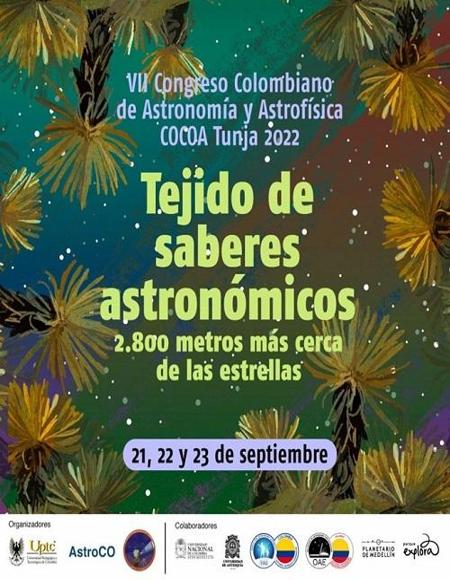Optimized Fuzzy System for automatic detection of planetary transits in light curves of individual stars

Abstract
The transit method is an effective way to find extrasolar planets. This method is based on the shallow decrease that a planet causes in its host star’s apparent brightness: when the planet passes through our line of sight, it affects the brightness we receive from the star with our telescopes. However, these transit events are very close to the telescopes’ detection sensitivity limit. To confirm a planet observation, it takes at least three (3) transit events, making long-time observations of a star necessary to detect extrasolar planets that may orbit it, which results in large amounts of data to be analized. In this work we did a new software pipeline
for autonomous detection of transit traces by analyzing extracted features from stellar light curves using a fuzzy logic classifier, avoiding the task of searching for transit events in each section of the light curves. During the development process of the software pipeline, the Knowledge Discovery in Databases (KDD) methodology is implemented, which presents a way to extract knowledge from large datasets.
Keywords
Computational intelligence, Extrasolar planets, Fuzzy logic, Global Optimization, Light curves, Transit method
References
- A. Megías, “Caracterización de sistemas exoplanetarios mediante el ajuste de series temporales fotométricas y de velocidad radial”, Trabajo de fin de Máster, Departa- mento de Física de la Tierra y Astrofísica, Facultad de Ciencias Físicas, Universidad Complutense de Madrid, Madrid, 2019.
- E.A. Rojas, “Análisis de curvas de luz de exoplanetas utilizando datos de la sonda espacial Kepler”, Trabajo de graduación, Departamento de Física, Universidad de San Carlos de Guatemala, Guatemala, 2016.
- P. Brennan, “Exoplanet Exploration: Planets Beyond our Solar System”, 2022. Disponible en https://exoplanets. nasa.gov/discovery/exoplanet-catalog. Obtenido en enero 11, 2023.
- J.G. Ahuatzi, “Ajuste simultáneo a curvas de luz y veloci- dad radial para sistemas en tránsito”, Instituto Nacional de Astrofísica, óptica y Electrónica, Puebla, México, 2014.
- G. Kovács, S. Zucker & T. Mazeh, “A box-fitting algo- rithm in the search for periodic transits”, en A&A, vol. 391, DOI: https://doi.org/10.1051/0004-6361:20020802
- no. 1, pp. 369-377, Agosto, 2002. https://doi.org/10.1051/ 0004- 6361:20020802
- D.Mislis,E.Bachelet,K.A.Alsubai,etal,“sidra:ablind algorithm for signal detection in photometric surveys”, en MNRAS, vol. 455, no. 1, pp. 626â633, Enero, 2016. https://doi.org/10.1093/mnras/stv2333 DOI: https://doi.org/10.1093/mnras/stv2333
- D.S. Julian, “Búsqueda de tránsitos planetarios alrededor de enanas ultrafrías”, Trabajo de fin de Máster, Universi- dad de La Laguna, 2019.
- NASAExoplanetScienceInstitute,“ExoplanetandCandi- date Statistics”[online]. NASA Exoplanet Archive, 2022. Disponible en https://exoplanetarchive.ipac.caltech.edu/ docs/counts_detail.html
- G.C.Sturrock,B.Manry&S.Rafiqi,“MachineLearning Pipeline for Exoplanet Classification”, en SMU Data Sci. Rev., vol. 2, no. 1, Article 9, 2019. https://scholar.smu.edu/ datasciencereview/vol2/iss1/9
- C. J Shallue & A. Vanderburg, “Identifying Exoplanets with Deep Learning: A Five-planet Resonant Chain around Kepler-80 and an Eighth Planet around Kepler-90”, en ApJ, vol. 155, no. 2, pp 21, 2018. https://doi.org/10.3847/ 1538- 3881/aa9e09 DOI: https://doi.org/10.3847/1538-3881/aa9e09
- M. Ansdell, Y. Ioannou, H. P. Osborn, et al, “Scientific Domain Knowledge Improves Exoplanet Transit Classifi- cation with Deep Learning”, en ApJL, vol. 869, L7, 2018. https://doi.org/10.3847/2041-8213/aaf23b DOI: https://doi.org/10.3847/2041-8213/aaf23b
- L.Ofman,A.Averbuch,A.Shliselberg,etal,“Automated identification of transiting exoplanet candidates in NASA Transiting Exoplanets Survey Satellite (TESS) data with machine learning methods”, en NewA, vol. 91, no. 1, 2022. https://doi.org/10.1016/j.newast.2021.101693 DOI: https://doi.org/10.1016/j.newast.2021.101693
- R.M.AsifAminetal,“Detectionofexoplanetsystemsin Kepler light curves using adaptive neuro-fuzzy system”, 2018 International Conference on Intelligent Systems (IS), pp. 66â72, 2018. https://doi.org/10.1109/IS.2018.8710502 DOI: https://doi.org/10.1109/IS.2018.8710502
- H. Valizadegan et al, “ExoMiner: A Highly Accurate and Explainable Deep Learning Classifier That Validates 301 New Exoplanets”, en ApJ, vol. 926, no. 2, pp. 120. https: //doi.org/10.3847/1538- 4357/ac4399 DOI: https://doi.org/10.3847/1538-4357/ac4399
- C. Moutou & F. Pont, “Detection and characterization of extrasolar planets: the transit method”, en Ecole de Goutelas, vol. 28, pp. 55â79, 2006. http://astro.u-strasbg. fr/goutelas/g2005/
- W. Frawley et al, “Knowledge Discovery in Databases: An Overview”, en AI Mag., 13(3), 57, 1992. https://doi. org/10.1609/aimag.v13i3.1011
- O. Maimon & L. Rokach, “Introduction to Knowledge Discovery in Databases”, en Data Mining and Knowled- ge Discovery Handbook. Springer, Boston, MA, pp 1-14. https://doi.org/10.1007/0-387-25465-X_1 DOI: https://doi.org/10.1007/0-387-25465-X_1
- F. Dernoncourt, “Introduction to fuzzy logic”, [online]. Massachusetts Institute of Technology, Cambridge, MA. 2013. Disponible en http://aisii.azc.uam.mx/mcbc/Cursos/ IntCompt/Lectura15.pdf
- Serena Yeung, “What is Computer Vision?”[online]. Stan- ford Artificial Intelligence Laboratory’s Outreach Summer camp (SAILORS), 2015. Disponible en https://ai.stanford. edu/~syyeung/cvweb/tutorial1.html
- M. Clere, “Particle Swarm Optimization ”, en Hermes Science/Lavoisier, Paris, Francia, 2005. https://doi.org/10. 1002/9780470612163
- Robinson, Jacob & Rahmat-Samii, Yahya. “Y.: Particle Swarm Optimization in Electromagnetics. IEEE Trans. on Antennas and Propagation Antennas and Propagation. https://doi.org/10.1109/TAP.2004.823969 DOI: https://doi.org/10.1109/TAP.2004.823969
- “Exoplanet Hunting in Deep Space”[online], Kag- gle, 2016. Disponible en https://www.kaggle.com/ keplersmachines/kepler-labelled-time-series-data
- J. H. Catanzarite, “Autovetter Planet Candidate Catalog for Q1-Q17 Data Release 24”, NASA Ames Research Center, 2015. KSCI-19091-001
- G.Lemaitreetal,“Imbalanced-learn:APythonToolbox to Tackle the Curse of Imbalanced Datasets in Machine Learning”, arXiv, 2016. https://doi.org/10.48550/ARXIV. 1609.06570
- F. Pedregosa et al, “Scikit-learn: Machine Learning in Python”, arXiv, 2012. https://doi.org/10.48550/ARXIV. 1201.0490
- U. Rajendra et al, “Application of entropies for automated diagnosis of epilepsy using EEG signals: A review”, en
- Knowledge-Based Syst., vol. 88, pp. 85-96, Noviembre, 2015. https://doi.org/10.1016/j.knosys.2015.08.004 DOI: https://doi.org/10.1016/j.knosys.2015.08.004
- O. Ulkir et al, “Emg Signal Classification Using Fuzzy Logic”, en Balkan j. Electric. Comput. Eng., vol. 5, no. 2, pp. 97-101, Septiembre, 2017, https://doi.org/10.17694/ bajece.337941 DOI: https://doi.org/10.17694/bajece.337941
- P.Virtanenetal,“SciPy1.0:fundamentalalgorithmsfor scientific computing in Python”, en Nat. Methods, vol. 17, pp. 261-272, Febrero 2020. https://doi.org/10.1038/ s41592-019-0686-2
- C. R. Harris et al, “Array programming with NumPy”, en Nat, vol. 585, pp. 357-362, 2020. https://doi.org/10.1038/ s41586-020-2649-2 DOI: https://doi.org/10.1038/s41586-020-2649-2
- F.Baoetal,“PyEEG:AnOpenSourcePythonModulefor EEG/MEG Feature Extraction”, en Comput. Intell. Neu- rosci., vol. 2011, 406391, 2011. https://doi.org/10.1155/ 2011/406391
- J.Warneretal,“JDWarner/scikit-fuzzy:Scikit-Fuzzyver- sion 0.4.2 (v0.4.2)”, Zenodo, 2019. https://doi.org/10. 5281/zenodo.802396
- J.Demsaretal,“Orange:DataMiningToolboxinPython”, en j. Mach. Learn. Res., vol. 14, pp. 2349-2353, 2013. http://jmlr.org/papers/v14/demsar13a.html
- M.S.Nobileetal,“FuzzySelf-TuningPSO:ASettings- Free Algorithm for Global Optimization”, en Swarm Evol. Comput., vol. 39, pp. 70-85, Abril, 2018. https://doi.org/ 10.1016/j.swevo.2017.09.001 DOI: https://doi.org/10.1016/j.swevo.2017.09.001